Sensor fusion combines data from multiple sensors to create a more accurate and comprehensive understanding of the environment, enhancing decision-making in IoT systems. Data aggregation, in contrast, collects and summarizes sensor data to reduce communication overhead and improve efficiency without necessarily increasing data precision. Employing sensor fusion enables real-time processing and refined insights, while data aggregation optimizes bandwidth and storage.
Table of Comparison
| Aspect | Sensor Fusion | Data Aggregation |
|---|---|---|
| Definition | Combining data from multiple sensors to produce more accurate, reliable, and comprehensive information. | Collecting and summarizing data from multiple sources to reduce data volume and extract meaningful insights. |
| Purpose | Enhance data quality and sensor accuracy for improved decision-making. | Optimize data transmission and storage by condensing data. |
| Process | Data-level integration with algorithms like Kalman filters and Bayesian networks. | Data summarization using techniques such as averaging, filtering, and compression. |
| Output | Fused sensor data providing higher fidelity and reduced uncertainty. | Aggregated data that is concise, often statistical summaries. |
| Application | Navigation systems, autonomous vehicles, health monitoring sensors. | Environmental monitoring, smart city data collection, IoT data management. |
| Benefits | Improved accuracy, robustness, and fault tolerance in sensor data. | Reduced bandwidth, lower storage demands, and efficient data processing. |
Understanding Sensor Fusion in IoT
Sensor fusion in IoT refers to the process of integrating data from multiple sensors to produce more accurate, reliable, and comprehensive information than individual sensors alone. Unlike data aggregation, which simply collects and compiles raw sensor data, sensor fusion applies algorithms and models to analyze and correlate sensor inputs, enhancing contextual awareness and decision-making. This technique is crucial in IoT applications such as autonomous vehicles, smart homes, and industrial automation, where real-time, precise environmental perception is essential.
What Is Data Aggregation in IoT?
Data aggregation in IoT refers to the process of collecting and combining data from multiple sensors or devices to reduce redundancy and enhance data quality before transmission or analysis. This technique optimizes network bandwidth and storage by summarizing or compressing raw sensor data into meaningful information. Effective data aggregation improves decision-making accuracy and resource efficiency across diverse IoT applications such as smart cities, industrial automation, and environmental monitoring.
Key Differences: Sensor Fusion vs Data Aggregation
Sensor fusion combines data from multiple sensors to create a more accurate, reliable, and comprehensive understanding of an environment, whereas data aggregation involves collecting and summarizing raw data from sensors without integrating it at a semantic level. Sensor fusion applies algorithms to reconcile and interpret conflicting sensor inputs, enhancing decision-making in IoT systems, while data aggregation primarily focuses on reducing data volume for efficient transmission or storage. The key difference lies in fusion's ability to synthesize data into actionable insights versus aggregation's emphasis on data collection and consolidation.
Benefits of Sensor Fusion in IoT Applications
Sensor fusion enhances IoT applications by integrating data from multiple sensors to provide more accurate, reliable, and comprehensive insights than data aggregation alone. This approach reduces noise and inconsistencies, enabling precise decision-making in smart environments, autonomous vehicles, and industrial automation. By leveraging sensor fusion, IoT systems achieve improved situational awareness, sensor fault tolerance, and enhanced context understanding.
Advantages of Data Aggregation for IoT Devices
Data aggregation enhances IoT device efficiency by consolidating raw sensor data into meaningful summaries, reducing bandwidth usage and storage requirements. It improves real-time decision-making capabilities by providing a holistic view of collected data from multiple sensors. Lower energy consumption results from decreased data transmission, extending the battery life of IoT devices in remote or resource-constrained environments.
Use Cases: When to Use Sensor Fusion
Sensor fusion is ideal for autonomous vehicles, industrial robots, and smart wearables where combining data from multiple sensors enhances accuracy and situational awareness. It enables real-time decision-making by integrating inputs such as LiDAR, radar, and cameras to create a comprehensive environmental model. Unlike data aggregation, which collects and summarizes raw data, sensor fusion synthesizes sensor outputs to improve reliability and performance in critical IoT applications.
Use Cases: When Data Aggregation Excels
Data aggregation excels in use cases where large-scale environmental monitoring requires combining data from numerous homogeneous sensors to provide a comprehensive overview, such as in smart cities and agriculture. It efficiently condenses raw sensor outputs into meaningful metrics, optimizing bandwidth and storage for real-time analytics and decision-making. This approach suits scenarios prioritizing data volume reduction and trend analysis over precise individual sensor calibration found in sensor fusion.
Challenges in Implementing Sensor Fusion
Implementing sensor fusion in the Internet of Things involves complex challenges such as handling heterogeneous data formats from diverse sensors and ensuring real-time processing for accurate decision-making. Synchronization of data streams and mitigating noise or inaccuracies require advanced algorithms and robust communication protocols. Scalability issues arise as the number of connected sensors increases, demanding efficient computational resources and energy management.
Overcoming Data Aggregation Limitations
Sensor fusion integrates data from multiple sensors to create a more accurate and comprehensive understanding of the environment, overcoming the limitations of simple data aggregation by reducing redundancy and improving data quality. Unlike data aggregation, which primarily combines raw data, sensor fusion processes and interprets sensor inputs to enhance decision-making in IoT systems. This approach is crucial for applications requiring high precision and reliability, such as autonomous vehicles and smart healthcare devices.
Choosing the Right Approach for Your IoT Solution
Sensor fusion integrates data from multiple sensors to produce more accurate, reliable, and comprehensive information, enhancing decision-making in complex IoT environments. Data aggregation collects and summarizes sensor data, reducing bandwidth and storage requirements while providing a consolidated overview for analysis. Selecting between sensor fusion and data aggregation depends on your IoT solution's need for real-time accuracy, computational resources, and the level of data detail required.
Sensor fusion vs Data aggregation Infographic

 techiny.com
techiny.com